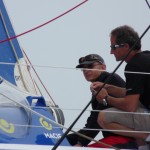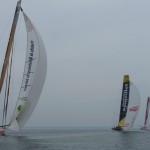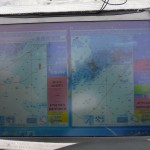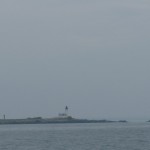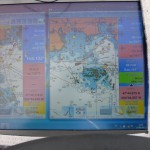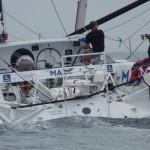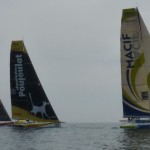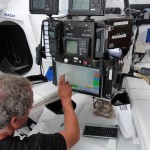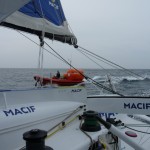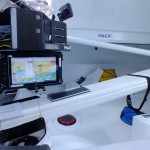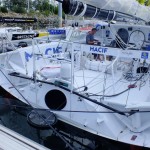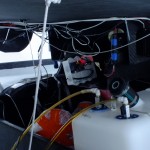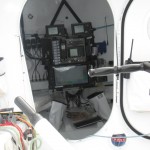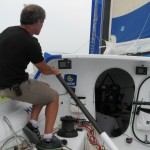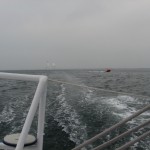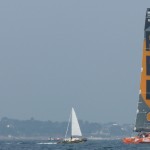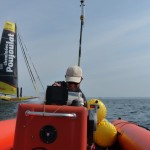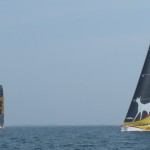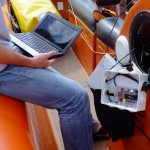Project leader : Frédéric Raimbault
Participants : Frédéric Guidec , Nicolas Le Sommer, Gwenaël Le Maguer.
Objectives

Training race between 4 IMOCA (60-foot monohull)
The “Pôle Finistère Course au Large” and the Adrena company and the IRISA laboratory of the Bretagne Sud University have signed an agreement to test an exchange system of navigation data in real time during training sessions. In this context, the CASA team at IRISA develops an embedded solution, called Ship2ship, that ensures the automatic exchange of navigation data between two boats. This solution will be tested and used by the sailors of the PFCL. This will allow them to compare their real-time tactical choices and their settings. Further extensions like the exchange of sail’s photos are planned for the future.
Partners

“Pôle Finistère Course au Large” has for mission to train and follow the high level sportsmen racing offshore mainly on IMOCA 60-foot monohull and monotypes Figaro Beneteau II.

Adrena is a software editor company specialised in racing navigation software and performance analysis tools.

CASA is a research group of laboratory IRISA, Bretagne Sud University (city of Vannes). The CASA team has a scientific and technical expertise in the field of mobile ad-hoc networks (MANET). We develop protocols, tools and applications to exploit direct communication between mobiles without using any infrastructure. We are trying to apply ours solutions in the maritime domain under the SeaWAN activity (in french).
The Ship2ship system
Ship2ship is an embedded system designed specifically by our team to be easily placed in a boat. Two versions have been developped : one requiring a dedicated nano-PC on which the onboard PC is connected (Wi-Fi or Ethernet link) ; the other one is running directly on the onboard computer. In both cases the Ship2ship system allows data from the central board navigation to be broadcast and data from the surrounding vessels to be received. The transmission technology between ships is either the Wi-Fi (adhoc mode) either the UHF (868 MHz).
Overview
The sailors of PFCL have aboard their ship a laptop PC with a tactical software (Adrena, Deckman, Expedition,…) that helps them in their navigation and their tactical choices. It analyzes data from the navigation unit and it summarizes it for the skipper in graphical form. The Ship2ship system interfaces with Adrena and behaves like a wireless bridge between two remote instances of the Adrena software: Ship2ship reads data from Adrena and sends them to the remote ship that can display them in Adrena as it does for those from its local navigation central.
The connection between Ship2ship and the tactical software is based on the possibility for the latter to duplicate on a UDP port all the data of the navigation center it receives as input; It is enough to set Ship2ship to listen on this port. This ability to duplicate data is a feature offered by the majority of tactical softwares. Once Ship2ship has been initialized, the skipper can display on his screen two instances of his navigation software: the usual one containing the information of his local ship and the other containing the information of the remote ship.
Hardware part
In its version with nano-PC, the system consists of a sealed box connected to an antenna / Wi-Fi modem marine WL400. or a XBee-PRO 868 module. The box contains a micro-PC (a Raspberry-Pi) which is connected to a Wi-Fi dongle for connection to the on-board PC, and also connected to the marine antenna or the XBee module for connection to the others ships.
The nano-PC version requires only the Wi-Fi antenna / modem or the XBee-PRO 868 radio module directly connected to the on-board PC.
Software part
Ship2ship implements opportunistic communications technologies developed in our team: in the event of too large remoteness, the exchanges between vessels are suspended and they resume spontaneously when the ships are back in radio range. Ship2ship is also designed for any number of vessels and thereafter a mechanism (multi-hop communications) using intermediate relay ship within radio range will be implemented.
Ship2ship has a graphical interface to facilitate the configuration and verify its correct operation. For example, local and received position data are analyzed in real time and the distance with each identified vessel is displayed. Ship2ship is written in Java; It runs in a Windows or Linux environment.
The software developped in Ship2Ship has been registered with the French Agence pour la Protection des Programmes (IDDN.FR.001.240028.000.S.P.2016.000.10200).
Experiments of august 26, 2013
As part of a training session between four 60-foot monohull at the PFCL, we installed the Ship2ship system aboard MACIF (winner of the race around the world Vendée Globe) and aboard a rigid-hulled inflatable boat. The objectives were to test the feasibility of the installation and the functionality of the system in real conditions and the scope of inter-ship exchanges. On these three points the results are very convincing (up to 1520 m recorded for the radio range). Others experiments are planed in the following months.
- GPS track of the day : approximatively 60 milles, between Port La Forêt, les Glénans and la Pointe de Penmarc’h.
- Pictures of the installation and of the day at sea: (click to enlarge) :
Experiments of september 24, 2014
The version of Ship2ship based on UHF technology was tested on September 24, 2014. It helps the implementation of this type of equipment on board ships as racing sailboats are already equipped with a VHF antenna at the top of the mat ; futhermore it extends its operational reach on the sea. We tested this type of equipment at sea during an experimental day with several IETR colleagues. The UCPA (its National Center is based at the BSM of Lorient) has put two boat houses and two skippers at our disposal to prepare and conduct in very good conditions these tests. In addition to testing specifically for Ship2ship, our IETR colleagues completed a series of flow and range measurements in the UHF frequency range. Our results indicate a significant improvement in the range of Ship2ship (up to 5700m or 3.1 NM).
- Day track : 25 miles in the groves of Groix
- Photos of the installation and day at sea (click to enlarge):






